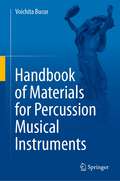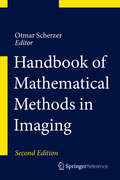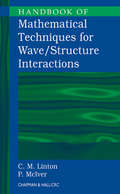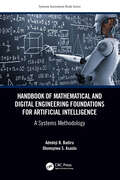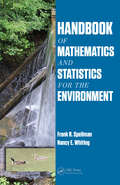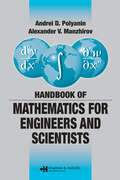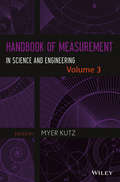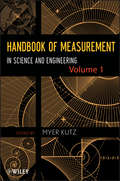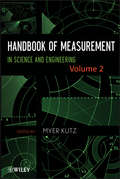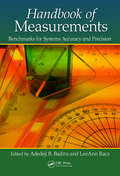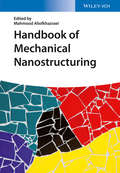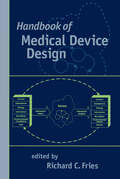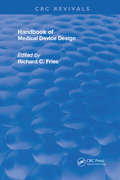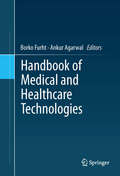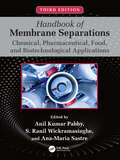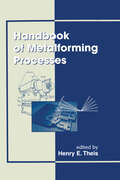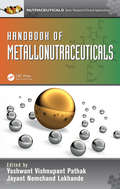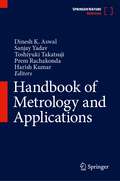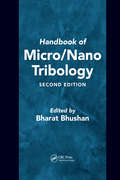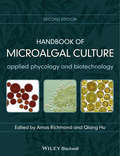- Table View
- List View
Handbook of Materials for Percussion Musical Instruments
by Voichita BucurThis book describes the properties of materials used for making percussion instruments for classical music played by a symphony orchestra in which the instruments could be played as a soloist instrument or as a group or several groups of instruments, as they are included into a musical work. A chapter is devoted to the bells. The scope of this book is primarily confined to percussion instruments of symphony orchestras taking into account the centuries of musical art and tradition. This book bridges the gap in the technical literature on describing the properties of materials for percussion instruments—timpani, other drums, marimba, xylophone, vibraphone, gong, cymbal, triangle, celesta, castanets.
Handbook of Mathematical Methods in Imaging
by Otmar ScherzerThe Handbook of Mathematical Methods in Imaging provides a comprehensive treatment of the mathematical techniques used in imaging science. The material is grouped into two central themes, namely, Inverse Problems (Algorithmic Reconstruction) and Signal and Image Processing. Each section within the themes covers applications (modeling), mathematics, numerical methods (using a case example) and open questions. Written by experts in the area, the presentation is mathematically rigorous. The entries are cross-referenced for easy navigation through connected topics. Available in both print and electronic forms, the handbook is enhanced by more than 150 illustrations and an extended bibliography. It will benefit students, scientists and researchers in applied mathematics. Engineers and computer scientists working in imaging will also find this handbook useful.
Handbook of Mathematical Techniques for Wave/Structure Interactions
by C.M. Linton P. McIverAlthough a wide range of mathematical techniques can apply to solving problems involving the interaction of waves with structures, few texts discuss those techniques within that context-most often they are presented without reference to any applications. Handbook of Mathematical Techniques for Wave/Structure Interactions brings together some of the
Handbook of Mathematical and Digital Engineering Foundations for Artificial Intelligence: A Systems Methodology (Systems Innovation Book Series)
by Adedeji B. Badiru Olumuyiwa AsaoluArtificial intelligence (AI) and digital engineering have become prevalent in business, industry, government, and academia. However, the workforce still has a lot to learn on how to leverage them. This handbook presents the preparatory and operational foundations for the efficacy, applicability, risk, and how to take advantage of these tools and techniques. Handbook of Mathematical and Digital Engineering Foundations for Artificial Intelligence: A Systems Methodology provides a guide for using digital engineering platforms for advancing AI applications. The book discusses an interface of education and research in the pursuit of AI developments and highlights the facilitation of advanced education through AI and digital engineering systems. It presents an integration of soft and hard skills in developing and using AI and offers a rigorous systems approach to understanding and using AI. This handbook will be the go-to resource for practitioners and students on applying systems methodology to the body of knowledge of understanding, embracing, and using digital engineering tools and techniques. The recent developments and emergence of Chatbots (AI tools) all have mathematical foundations for their efficacy. Such AI tools include ChatGPT, GPT-4, Bard, Tidio Support Bot, Kuki AI Companion, Meena, BlenderBot, Rose AI Chatbot, Replika: AI Friend, Eviebot, and Tay. This handbook highlights the importance of mathematical and digital foundations for AI developments. The handbook will enhance the understanding and appreciation of readers about the prevailing wave of artificial intelligence products, and, thereby, fitting the current market needs.
Handbook of Mathematics and Statistics for the Environment
by Frank R. Spellman Nancy E. WhitingA thorough revision of the previous "Environmental Engineer's Mathematics Handbook," this book offers readers an unusual approach to presenting environmental math concepts, emphasizing the relationship between the principles in natural processes and environmental processes. It integrates the fundamental math operations performed by environmental pr
Handbook of Mathematics for Engineers and Scientists (ISSN)
by Andrei D. Polyanin Alexander V. ManzhirovCovering the main fields of mathematics, this handbook focuses on the methods used for obtaining solutions of various classes of mathematical equations that underlie the mathematical modeling of numerous phenomena and processes in science and technology. The authors describe formulas, methods, equations, and solutions that are frequently used in scientific and engineering applications and present classical as well as newer solution methods for various mathematical equations. The book supplies numerous examples, graphs, figures, and diagrams and contains many results in tabular form, including finite sums and series and exact solutions of differential, integral, and functional equations.
Handbook of Measurement in Science and Engineering, Volume 1
by Myer KutzEncyclopedic in scope, this volume is a multidisciplinary reference of engineering measurement tools, techniques, and applications. Whether engineers are attempting to state requirements quantitatively and demonstrate compliance, to track progress and predict results, or to analyze costs and benefits, they must use the right tools and techniques to produce meaningful, useful data. This volume covers civil and environmental engineering, mechanical and biomedical engineering, and industrial engineering and is the most comprehensive, up-to-date reference set on engineering measurements beyond anything on the market today.
Handbook of Measurement in Science and Engineering, Volume 1
by Myer KutzA multidisciplinary reference of engineering measurement tools, techniques, and applications—Volume 1 "When you can measure what you are speaking about, and express it in numbers, you know something about it; but when you cannot measure it, when you cannot express it in numbers, your knowledge is of a meager and unsatisfactory kind; it may be the beginning of knowledge, but you have scarcely in your thoughts advanced to the stage of science." — Lord Kelvin Measurement falls at the heart of any engineering discipline and job function. Whether engineers are attempting to state requirements quantitatively and demonstrate compliance; to track progress and predict results; or to analyze costs and benefits, they must use the right tools and techniques to produce meaningful, useful data. The Handbook of Measurement in Science and Engineering is the most comprehensive, up-to-date reference set on engineering measurements—beyond anything on the market today. Encyclopedic in scope, Volume 1 spans several disciplines—Civil and Environmental Engineering, Mechanical and Biomedical Engineering, and Industrial Engineering—and covers: New Measurement Techniques in Structural Health Monitoring Traffic Congestion Management Measurements in Environmental Engineering Dimensions, Surfaces, and Their Measurement Luminescent Method for Pressure Measurement Vibration Measurement Temperature Measurement Force Measurement Heat Transfer Measurements for Non-Boiling Two-Phase Flow Solar Energy Measurements Human Movement Measurements Physiological Flow Measurements GIS and Computer Mapping Seismic Testing of Highway Bridges Hydrology Measurements Mobile Source Emissions Testing Mass Properties Measurement Resistive Strain Measurement Devices Acoustics Measurements Pressure and Velocity Measurements Heat Flux Measurement Wind Energy Measurements Flow Measurement Statistical Quality Control Industrial Energy Efficiency Industrial Waste Auditing Vital for engineers, scientists, and technical managers in industry and government, Handbook of Measurement in Science and Engineering will also prove ideal for members of major engineering associations and academics and researchers at universities and laboratories.
Handbook of Measurement in Science and Engineering, Volume 2
by Myer KutzA multidisciplinary reference of engineering measurement tools, techniques, and applications—Volume 2 "When you can measure what you are speaking about, and express it in numbers, you know something about it; but when you cannot measure it, when you cannot express it in numbers, your knowledge is of a meager and unsatisfactory kind; it may be the beginning of knowledge, but you have scarcely in your thoughts advanced to the stage of science." — Lord Kelvin Measurement falls at the heart of any engineering discipline and job function. Whether engineers are attempting to state requirements quantitatively and demonstrate compliance; to track progress and predict results; or to analyze costs and benefits, they must use the right tools and techniques to produce meaningful, useful data. The Handbook of Measurement in Science and Engineering is the most comprehensive, up-to-date reference set on engineering measurements—beyond anything on the market today. Encyclopedic in scope, Volume 2 spans several disciplines—Materials Properties and Testing, Instrumentation, and Measurement Standards—and covers: Viscosity Measurement Corrosion Monitoring Thermal Conductivity of Engineering Materials Optical Methods for the Measurement of Thermal Conductivity Properties of Metals and Alloys Electrical Properties of Polymers Testing of Metallic Materials Testing and Instrumental Analysis for Plastics Processing Analytical Tools for Estimation of ParticulateComposite Material Properties Input and Output Characteristics Measurement Standards and Accuracy Tribology Measurements Surface Properties Measurement Plastics Testing Mechanical Properties of Polymers Nondestructive Inspection Ceramics Testing Instrument Statics Signal Processing Bridge Transducers Units and Standards Measurement Uncertainty Data Acquisition and Display Systems Vital for engineers, scientists, and technical managers in industry and government, Handbook of Measurement in Science and Engineering will also prove ideal for members of major engineering associations and academics and researchers at universities and laboratories.
Handbook of Measurements: Benchmarks for Systems Accuracy and Precision (Systems Innovation Book Series)
by Adedeji B. Badiru LeeAnn RaczPlanning, measuring, and paying attention to details form the basis for all successful engineering operations. Measurements pervade everything we do and must be viewed from a systems perspective. A comprehensive all-encompassing guide to measurements, Handbook of Measurements: Benchmarks for Systems Accuracy and Precision focuses on high-level engineering computations essential for benchmarks and technical innovation. The book uses a systems framework and a technically rigorous approach to systems linking of measurements—an approach that sets it apart from other handbooks.The popular saying "measure twice and cut once" bears out the importance of measurements in human endeavors. This handbook covers both qualitative and quantitative topics of measurement. It opens with a chapter on the fundamentals of measurement and includes coverage of human-centric measurements, such as measurement of personnel productivity and contractor performance. It concludes with three appendices on measurement, references, conversion factors, equations, formulas, and statistics for measurement.It is well understood that humans cannot manage anything that cannot be measured. All elements involved in our day-to-day decision making involve some form of measurement, whether in the kitchen, retail, sports, service operations, geographical exploration, health care delivery, worker productivity, clothing design, engineering product design, or space craft launching. Measuring an attribute of a system and then analyzing it against some standard, some specification, some best practice, or some benchmark empower a decision maker to take appropriate and timely actions. This book gives you a guide for sustainable practices to ensure accurate measurements, helping you make decisions backed by metrics.
Handbook of Meat and Meat Processing
by Y. H. HuiRetitled to reflect expansion of coverage from the first edition, Handbook of Meat and Meat Processing, Second Edition, contains a complete update of materials and nearly twice the number of chapters. Divided into seven parts, the book covers the entire range of issues related to meat and meat processing, from nutrients to techniques for preservati
Handbook of Meat, Poultry and Seafood Quality
by Feng Chen Chris Kerth Patti Coggins Grethe Hydlig Terri Boylston L. H. McKeeA great need exists for valuable information on factors affecting the quality of animal related products. The second edition of Handbook of Meat, Poultry and Seafood Quality, focuses exclusively on quality aspects of products of animal origin, in depth discussions and recent developments in beef, pork, poultry, and seafood quality, updated sensory evaluation of different meat products, revised microbiological aspects of different meat products. Also, included are new chapters on packaging, new chapters and discussion of fresh and frozen products, new aspects of shelf life and recent developments in research of meat tainting. This second edition is a single source for up-to-date and key information on all aspects of quality parameters of muscle foods is a must have. The reader will have at hand in one focused volume covering key information on muscle foods quality.
Handbook of Mechanical Alloy Design
by George E. Totten Lin Xie Kiyoshi FunataniOffering one of the field's most thorough treatments of material design principles, including a concise overview of fastener design, the Handbook of Mechanical Alloy Design provides an extensive overview of the effects of alloy compositional design on expected mechanical properties. This reference highlights the design elements that must be c
Handbook of Mechanical Nanostructuring, 2 Volume Set
by Mahmood AliofkhazraeiProviding in-depth information on how to obtain high-performance materials by controlling their nanostructures, this ready reference covers both the bottom-up and the top-down approaches to the synthesis and processing of nanostructured materials. The focus is on advanced methods of mechanical nanostructuring such as severe plastic deformation, including high pressure torsion, equal channel angular processing, cyclic extrusion compression, accumulative roll bonding, and surface mechanical attrition treatment. As such, the contents are inherently application-oriented, with the methods presented able to be easily integrated into existing production processes. In addition, the structure-property relationships and ways of influencing the nanostructure in order to exhibit a desired functionality are reviewed in detail. The whole is rounded off by a look at future directions, followed by an overview of applications in various fields of structural and mechanical engineering. With its solutions for successful processing of complex-shaped workpieces and large-scale specimens with desired properties, this is an indispensable tool for purposeful materials design.
Handbook of Medical Device Design
by Richard C. FriesThe Handbook of Medical Device Design provides a review of regulatory and standards issues in medical device design, including FDA regulations, types of 510 (k), the ISO 9000 series, and medical device directives. It identifies how to determine and document customer needs and device requirements. It also establishes reliability and qua
Handbook of Medical Device Design (Routledge Revivals)
by Richard C. FriesFirst published in 2001: This handbook has been written to give those professionals working in the development and use of medical devices practical knowledge about biomedical technology, regulations, and their relationship to quality health care.
Handbook of Medical and Healthcare Technologies
by Borko Furht Ankur AgarwalThis book equips readers to understand a complex range of healthcare products that are used to diagnose, monitor, and treat diseases or medical conditions affecting humans. The first part of the book presents medical technologies such as medical information retrieval, tissue engineering techniques, 3D medical imaging, nanotechnology innovations in medicine, medical wireless sensor networks, and knowledge mining techniques in medicine. The second half of the book focuses on healthcare technologies including prediction hospital readmission risk, modeling e-health framework, personal Web in healthcare, security issues for medical records, and personalized services in healthcare. The contributors are leading world researchers who share their innovations, making this handbook the definitive resource on these topics. Handbook of Medical and Healthcare Technologies is intended for a wide audience including academicians, designers, developers, researchers and advanced-level students. It is also valuable for business managers, entrepreneurs, and investors within the medical and healthcare industries.
Handbook of Membrane Separations: Chemical, Pharmaceutical, Food, and Biotechnological Applications
by Anil Kumar Pabby S. Ranil Wickramasinghe Ana-Maria SastreThe third edition of the Handbook of Membrane Separations: Chemical, Pharmaceutical, Food, and Biotechnological Applications provides a comprehensive discussion of membrane applications. Fully updated to include the latest advancements in membrane science and technology, it is a one-of-its-kind overview of the existing literature. This fully illustrated handbook is written by experts and professionals in membrane applications from around the world. Key Features: • Includes entirely new chapters on organic solvent-resistant nanofiltration, membrane condensers, membrane-reactors in hydrogen production, membrane materials for haemodialysis, and integrated membrane distillation • Covers the full spectrum of membrane technology and its advancements • Explores membrane applications in a range of fields, from biotechnological and food processing to industrial waste management and environmental engineering This book will appeal to both newcomers to membrane science as well as engineers and scientists looking to expand their knowledge on upcoming advancements in the field.
Handbook of Memristor Networks
by Leon Chua Georgios Ch. Sirakoulis Andrew AdamatzkyThis Handbook presents all aspects of memristor networks in an easy to read and tutorial style. Including many colour illustrations, it covers the foundations of memristor theory and applications, the technology of memristive devices, revised models of the Hodgkin-Huxley Equations and ion channels, neuromorphic architectures, and analyses of the dynamic behaviour of memristive networks. It also shows how to realise computing devices, non-von Neumann architectures and provides future building blocks for deep learning hardware.With contributions from leaders in computer science, mathematics, electronics, physics, material science and engineering, the book offers an indispensable source of information and an inspiring reference text for future generations of computer scientists, mathematicians, physicists, material scientists and engineers working in this dynamic field.
Handbook of Metalforming Processes
by Henry Ericsson TheisReflecting hands-on experience of materials, equipment, tooling and processes used in the industry, this work provides up-to-date information on flat-rolled sheet metal products. It addresses the processing and forming of light-to-medium-gauge flat-rolled sheet metal, illustrating the versatility and myriad uses of this material.
Handbook of Metallonutraceuticals (Nutraceuticals)
by Yashwant Vishnupant Pathak Jayant Nemchand LokhandeThe nutritional and medicinal value of metals, such as zinc, calcium, and iron, has been known in traditional medicine for a long time. Other metals, such as silver and gold, may also have therapeutic and health benefits. Ancient medicines have long incorporated their use in the treatment of diseases, and they have also more recently been explored
Handbook of Metamaterial-Derived Frequency Selective Surfaces (Metamaterials Science and Technology #3)
by Shiv Narayan Arun KesavanThis volume provides a consolidated reference for the applications of frequency selective surfaces (FSS) technology in different sectors such as wireless communications, smart buildings, microwave and medical industries. It covers all aspects of metamaterial FSS technology starting from theoretical simulation, fabrication and measurement all the way to actual hardware implementation. Also included are in-depth discussions on the design methodologies of metamaterial FSS structures and their practical implementation in devices and components. It will be of interest to researchers and engineers working on developing metamaterial-FSS technology.
Handbook of Metrology and Applications
by Harish Kumar Sanjay Yadav Dinesh K. Aswal Toshiyuki Takatsuji Prem RachakondaThis handbook provides comprehensive and up-to-date information on the topic of scientific, industrial and legal metrology. It discusses the state-of-art review of various metrological aspects pertaining to redefinition of SI Units and their implications, applications of time and frequency metrology, certified reference materials, industrial metrology, industry 4.0, metrology in additive manufacturing, digital transformations in metrology, soft metrology and cyber security, optics in metrology, nano-metrology, metrology for advanced communication, environmental metrology, metrology in biomedical engineering, legal metrology and global trade, ionizing radiation metrology, advanced techniques in evaluation of measurement uncertainty, etc. The book has contributed chapters from world’s leading metrologists and experts on the diversified metrological theme. The internationally recognized team of editors adopt a consistent and systematic approach and writing style, including ample cross reference among topics, offering readers a user-friendly knowledgebase greater than the sum of its parts, perfect for frequent consultation. Moreover, the content of this volume is highly interdisciplinary in nature, with insights from not only metrology but also mechanical/material science, optics, physics, chemistry, biomedical and more. This handbook is ideal for academic and professional readers in the traditional and emerging areas of metrology and related fields.
Handbook of Micro/Nano Tribology
by Bharat BhushanThis second edition of Handbook of Micro/Nanotribology addresses the rapid evolution within this field, serving as a reference for the novice and the expert alike. Two parts divide this handbook: Part I covers basic studies, and Part II addresses design, construction, and applications to magnetic storage devices and MEMS.Discussions include:surface physics and methods for physically and chemically characterizing solid surfacesroughness characterization and static contact models using fractal analysissliding at the interface and friction on an atomic scalescratching and wear as a result of slidingnanofabrication/nanomachining as well as nano/picoindentationlubricants for minimizing friction and wearsurface forces and microrheology of thin liquid filmsmeasurement of nanomechanical properties of surfaces and thin filmsatomic-scale simulations of interfacial phenomenamicro/nanotribology and micro/nanomechanics of magnetic storage devicesThis comprehensive book contains 16 chapters contributed by more than 20 international researchers. In each chapter, the presentation starts with macroconcepts and then lead to microconcepts. With more than 500 illustrations and 50 tables, Handbook of Micro/Nanotribology covers the range of relevant topics, including characterization of solid surfaces, measurement techniques and applications, and theoretical modeling of interfaces. What's New in the Second Edition? New chapters on:AFM instrumentationSurface forces and adhesionDesign and construction of magnetic storage devicesMicrodynamical devices and systemsMechanical properties of materials in microstructureMicro/nanotribology and micro/nanomechanics of MEMS devices
Handbook of Microalgal Culture
by Qiang Hu Amos RichmondAlgae are some of the fastest growing organisms in the world, with up to 90% of their weight made up from carbohydrate, protein and oil. As well as these macromolecules, microalgae are also rich in other high-value compounds, such as vitamins, pigments, and biologically active compounds, All these compounds can be extracted for use by the cosmetics, pharmaceutical, nutraceutical, and food industries, and the algae itself can be used for feeding of livestock, in particular fish, where on-going research is dedicated to increasing the percentage of fish and shellfish feed not derived from fish meal. Microalgae are also applied to wastewater bioremediation and carbon capture from industrial flue gases, and can be used as organic fertilizer.So far, only a few species of microalgae, including cyanobacteria, are under mass cultivation. The potential for expansion is enormous, considering the existing hundreds of thousands of species and subspecies, in which a large gene-pool offers a significant potential for many new producers.Completely revised, updated and expanded, and with the inclusion of new Editor, Qiang Hu of Arizona State University, the second edition of this extremely important book contains 37 chapters. Nineteen of these chapters are written by new authors, introducing many advanced and emerging technologies and applications such as novel photobioreactors, mass cultivation of oil-bearing microalgae for biofuels, exploration of naturally occurring and genetically engineered microalgae as cell factories for high-value chemicals, and techno-economic analysis of microalgal mass culture. This excellent new edition also contains details of the biology and large-scale culture of several economically important and newly-exploited microalgae, including Botryococcus, Chlamydomonas, Nannochloropsis, Nostoc, Chlorella, Spirulina, Haematococcus, and Dunaniella species/strains.Edited by Amos Richmond and Qiang Hu, each with a huge wealth of experience in microalgae, its culture, and biotechnology, and drawing together contributions from experts around the globe, this thorough and comprehensive new edition is an essential purchase for all those involved with microalgae, their culture, processing and use. Biotechnologists, bioengineers, phycologists, pharmaceutical, biofuel and fish-feed industry personnel and biological scientists and students will all find a vast amount of cutting-edge information within this Second Edition. Libraries in all universities where biological sciences, biotechnology and aquaculture are studied and taught should all have copies of this landmark new edition on their shelves.
